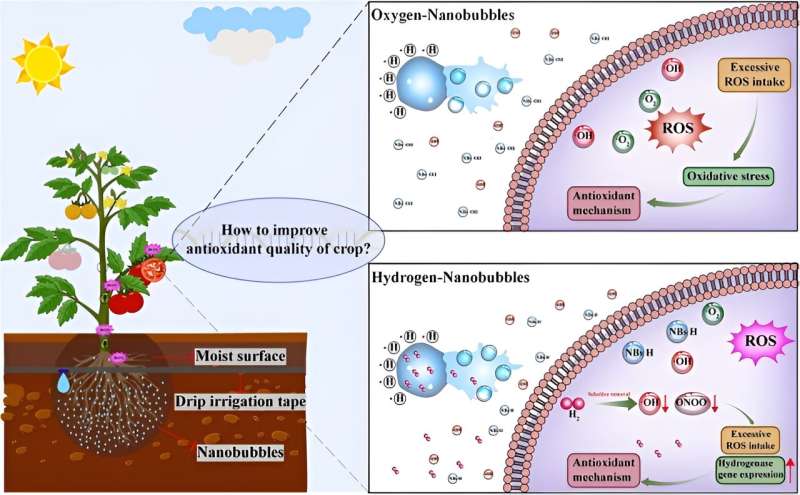This article has been reviewed according to Science X's editorial process and policies. Editors have highlighted the following attributes while ensuring the content's credibility:
fact-checked
peer-reviewed publication
proofread
Bubbling with benefits: Hydrogen nanobubbles boost tomato antioxidants

Tomatoes are a key source of antioxidants, crucial for human health as they help combat oxidative stress. Traditional irrigation methods often fail to significantly enhance these beneficial compounds in crops. Hydrogen, known for its unique antioxidant properties, faces challenges in agricultural use due to its low solubility and rapid diffusion.
These issues necessitate innovative irrigation techniques to improve crop quality and antioxidant levels. Based on these challenges, it is essential to conduct in-depth research to explore the potential of hydrogen nanobubble irrigation in agriculture.
Researchers from China Agricultural University, Hochschule Geisenheim University, and other institutions published a study on April 16, 2024, in Horticulture Research that explores the effects of hydrogen nanobubble irrigation on the antioxidant properties of tomato fruits.
The research indicates that this method significantly boosts the concentrations of various antioxidants in tomatoes.
The study utilized subsurface drip irrigation with hydrogen nanobubble water on tomato plants, revealing a significant increase in the concentrations of key antioxidants such as lycopene, ascorbic acid, flavonoids, and resveratrol, by 16.3–264.8% compared to traditional groundwater irrigation.
Through transcriptomic and metabolomic analyses, researchers identified that hydrogen nanobubbles modulate the electron transport chain and enhance the expression of genes involved in non-enzymatic antioxidant biosynthesis. This method promoted the synthesis of essential metabolites, resulting in higher antioxidant levels in the tomatoes.
The study highlights the unique ability of hydrogen nanobubbles to overcome the limitations of hydrogen's low solubility and fast diffusion in agricultural applications, offering a promising solution to enhance crop quality and health benefits for consumers. The findings underscore the potential of this innovative irrigation technique in improving agricultural productivity and crop resilience.
Dr. Yunkai Li, the corresponding author of the study, stated, "Our findings demonstrate the transformative potential of hydrogen nanobubble irrigation in agriculture. This method not only enhances the nutritional quality of tomatoes but also offers a sustainable solution to improve crop resilience and productivity. The integration of hydrogen with nanobubble technology addresses long-standing challenges in agricultural practices."
The application of hydrogen nanobubble irrigation could revolutionize agricultural practices by significantly improving the antioxidant content in crops. This method provides a sustainable approach to enhance crop quality, offering potential health benefits to consumers.
Future research should focus on optimizing the hydrogen requirements and irrigation frequency for different crops to fully harness the benefits of this technology.
More information: Jing He et al, Enhancing tomato fruit antioxidant potential through hydrogen nanobubble irrigation, Horticulture Research (2024). DOI: 10.1093/hr/uhae111
Journal information: Horticulture Research
Provided by China Agricultural University

















